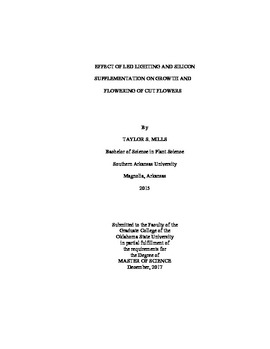| dc.description.abstract | Use of light emitting diodes (LED) technology is beginning to replace traditional lighting in greenhouses. This research focused on the effects of LED lighting and GA3 supplementation on growth and flowering of cut flowers. Dahlia spp. (Cav.) ‘Karma Serena’ and ‘Karma Maarten Zwaan’, Liatris spicata (Gaertn. ex Schreb) ‘Kobold’, and Lilium asiatic (L.) ‘Yellow Cocotte’ and ‘Montreux’ were subjected to varying light treatments including LED flowering lamps and halogen lamps. The flowering lamps emitted a combination of red + far-red + white and red + white. Photoperiod was extended by operating all lamps for 7 hours in the night and the experiment ran from late fall to early spring. Results varied within species and cultivars in response to light and GA3. Light was the most effective on growth and flowering characteristics especially in liatris and both cultivars of dahlia. In liatris, flowering occurred 2 weeks earlier under sole LED lighting than under other light treatments and no supplemental light. Although flowering occurred earliest in both cultivars of dahlias under no light, plants under light treatments had greater height, width, and shoot weight. There were significant effects of GA3 on growth and flowering characteristics in dahlia cultivars and lily cultivars such as greater height, width, and flower number. A significant interaction of light with GA3 influenced height, width, mean flower number, flower diameter, days to anthesis, and flowering percentage in several crops. The role of silicon (Si) as a needed supplement in soilless media is gaining interest. This research studied the effects of diatomaceous earth (DE) as a supplemental Si source on growth and flower characteristics, physiology, and nutrient uptake of cut flowers such as Dahlia spp. (Cav) ‘Dahlinova Montana’, Rudbeckia hirta (L.) ‘Denver Daisy’, and Gerbera jamesonii (L.) ‘Festival Light Eye White Shades’. Nine Si treatments were established, and plants were considered well-watered at 10 centibars or water-stressed at 20 centibars. Silicon treatments included application of DE across the top of the pots (top-dressed) incorporation, and Metro-Mix 360 media with and without Si. For each species, there were six pots per Si rate per irrigation treatment. Significant effects were seen from Si supplementation, irrigation, and interaction in all plants. Growth and flower characteristics, leaf nutrient content, and tolerance to stress were improved by application of DE. | |
